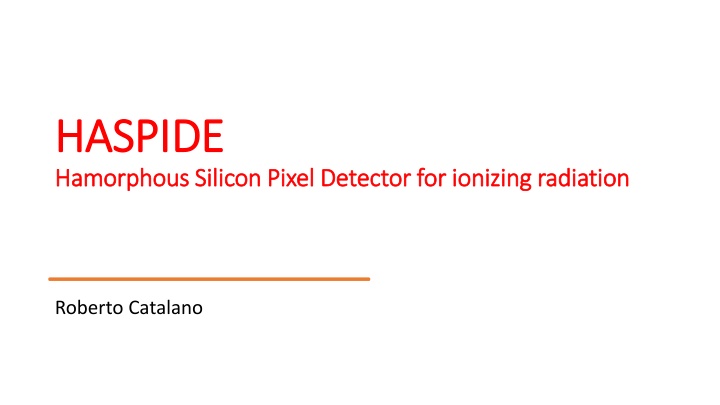
Exploration of Si-H as a Radiation Detector Material - HASPIDE Project
The HASPIDE project aims to investigate the potential of using Si-H as a radiation detector material for various types of ionizing radiation. The project involves exploring different detection regimes, applications in space, neutron detection, and more. With a focus on developing advanced electronic chains, the project seeks to enhance radiation detection capabilities for scientific and practical purposes.
Download Presentation

Please find below an Image/Link to download the presentation.
The content on the website is provided AS IS for your information and personal use only. It may not be sold, licensed, or shared on other websites without obtaining consent from the author. If you encounter any issues during the download, it is possible that the publisher has removed the file from their server.
You are allowed to download the files provided on this website for personal or commercial use, subject to the condition that they are used lawfully. All files are the property of their respective owners.
The content on the website is provided AS IS for your information and personal use only. It may not be sold, licensed, or shared on other websites without obtaining consent from the author.
E N D
Presentation Transcript
HASPIDE HASPIDE Hamorphous Silicon Pixel Detector for ionizing radiation Hamorphous Silicon Pixel Detector for ionizing radiation Roberto Catalano
Proponenti Proponenti Durata esperimento: 3 anni (2022-2024) Prolungamento 2025 Responsabile Nazionale: Dott. Leonello Servoli (INFN Perugia) Responsabile Locale: Roberto Catalano Unit partecipanti: INFN Perugia, INFN Firenze, INFN-LNS, INFN Milano, INFN Torino, INFN Lecce Coinvolgimenti esterni alla CSN5: Ecole Polytechnique Federale Lausanne (EPFL) University of Wollongong (UOW) WP1 Deposition process and device fabrication (PG, LE, EPFL) WP2 Electronic and DAQ (MI, PG, LNS, TO) WP3 Device simulation (PG, LNS, UOW) WP4 Beam monitoring (FI, LNS, PG, UOW) WP5 Space applications (FI) WP6 Neutron detection (LE) WP7 Project Management (PG)
Obiettivi generali Obiettivi generali The HASPIDE project wants to explore the possibility to use a:Si-H as a detection mate- rial for ionizing radiation of different types (photons, electrons, protons, ions, neu- trons). Two detection regimes should be tackled: the continuous or pulsed intense radiation flux (e.g., FLASH-RT); the pulse-by-pulse mode, typical of space applications or neutron detection. The material is very radiation-resistant, could be deposited as a thin layer of few mi- crometers over many substrates, including flexible ones like Kapton, that potentially opens the way toward many important applications: ionizing radiation flux measurement and dosimetry of charged particles and photon beams, both clinical and non-clinical ones (accuracy 2% without perturbing the in- coming radiation beam); detection of cosmic radiation in the spatial environment; neutron detection after deposition of a thin 10B converter layer.
Attivit Attivit Main goal: Realize an electronic chain based on the TERA-08 chip able to work in two dif- ferent configurations: continuous and pulsed proton beams. TERA-08 chip was realized by INFN-TO and available on the market through the DE.TEC.TOR. s.r.l. company It was designed for continuous beams LNS-INFN group modified it for pulsed beams (laser-driven applications) Acquisition by means of a PXIe FPGA 782x board We use LabView to configure the FPGA and thus set thr characteristics of the acquisition system (as the externally settable parameters of TERA08). In addition, LabView enables on-line data proces- sing, resulting in a significant spare of time. Thanks to: Antonino Amato (INFN-LNS) 1-year post-doc position from january 2024
Attivit Attivit Main goal: Realize an electronic chain based on the TERA-08 chip able to work in two dif- ferent configurations: continuous and pulsed proton beams. TERA-08 chip was realized by INFN-TO and available on the market through the DE.TEC.TOR. s.r.l. company It was designed for continuous beams LNS-INFN group modified it for pulsed beams (laser-driven applications) Acquisition by means of a PXIe FPGA 782x board Hardware assembling Realization and optimization of the software control system Electronic read-out characterization (background current, linearity of current-to- frequency conversion, charge conversion efficiency, gain uniformity, channel cross- talking) Detector characterization with pulsed proton beams accelerated by laser-matter inte- raction at ELI-Beamlines (Prague, Czech Republic) from October-November 2024
Budget e FTE Budget e FTE Nome FTE Consumo Catalano Roberto 0.10 Cirrone Giuseppe A. Pablo 0.15 Inventario Mariacristina Guarrera 0.30 Missioni Test elettronica 4 k Sp Servizi Totale 0.55 Totale 4 k
Impatto su divisioni e servizi LNS, eventuali necessit di spazi Impatto su divisioni e servizi LNS, eventuali necessit di spazi Reparto elettronica, convertitori di potenza, diagnostica ed automazioni





















